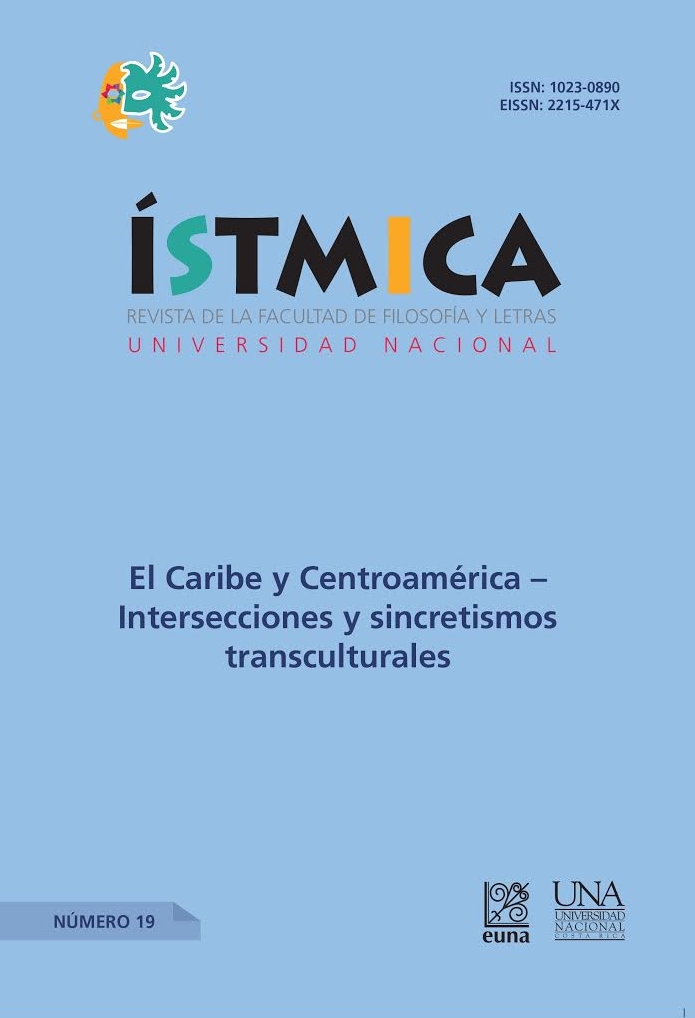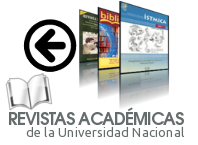Caribe de Esteban Ramírez, una excusa visual para la marginalización del afrocostarricense
DOI:
https://doi.org/10.15359/istmica.19.12Keywords:
Caribbean, fetishization, Afro-Costa RicaAbstract
In recent decades, the Caribbean Space and the figure of the Afro-Costa Rican have become a creative seed that could well be interpreted as a celebration of the symbols of an oppressed space and ethnicity. A detailed study shows, however, that the proposals are nothing more than anecdotal, stereotypical, exotic. This supposed insertion of the Caribbean and Afro-Costa Rican rather excludes and eliminates any real insertion, thus consolidating the traditional hegemonic discourses on which the Central Valley’s nationalism is founded, presenting other spaces as exotic and foreign. Esteban Ramirez’s Caribe (2004) is written under this assumption, depicting the Caribbean as an exotic space and those who live there as nothing more than foreigners, external to any real, inclusive national discourse. This essay looks at how the introduction of the Caribbean and Afro-Costa Ricans in a situation that portrays them as part of the homeland and a disjunctive view of the Caribbean as both idyllic and barbaric reconstructs a sense of exoticism that demonstrates a fragmented contemporaneity. Through a fetishization of the Caribbean, the lines of hegemony related to the ethnic debate and national identity are repositioned to create what Jerome Branche (1999) called a “new consensus or ‘definition’ of reality ultimately aimed at maintaining the status quo” of the dominant class (Negrismo: hibridez cultural, 485).
References
Baltodano Román, Gabriel. (2008). “Literatura y cine: el caso costarricense”. UNA-Purdue University. XVI Congreso Internacional de Literatura Centroamericana (Cilca), Sede Regional Chorotega UNA, San José. Abril 2008. Presentación en conferencia.
Barthes, Roland. (2008). La cámara lúcida. Nota sobre la fotografía. Buenos Aires: Paidós.
Branche, Jerome. (1999). “Negrismo: hibridez cultural, autoridad y la cuestión de la nación”. Revista Iberoamericana. Literatura Afro-hispánica. 188-189 (Julio-Diciembre 1999): 483-504.
Bolaños Esquivel, Bernardo y Guillermo González Campos. (2005). “Literatura y cine: procesos de reestructura y transformaciones discursivas en la película Caribe.” Intersedes. Vl (11-2005): 17-26. Web. 27 de septiembre de 2015.
Burton, Julianne. (2004). The Social documentary in Latin America. Pittsburgh: University of Pittsburgh Pres.
Calvo, Ernesto Calvo. (2004). “La otra Costa Rica”. La Nación 6 noviembre 2004: 14.
Campos, Domingo y Ciska Raventós. (2004). “Combo del ICE en el momento culminante De las protestas Sondeo telefónico 24-25 de marzo del 2000”.Revista de Ciencias Sociales (Cr) IV 106 (2004): 35-43.
Cañas, Alberto. (2004). “Chisporroteos”. La República 6 y 7 noviembre 2004: 15.
Caribe. Dir. Esteban Ramírez. Cinetel S.A, 2004. Film.
Cortés, María Lourdes (2002). El espejo imposible: un siglo de cine en Costa Rica San José: Farben Grupo Editorial Norma.
__________. (2006). “El nuevo siglo arranca en las pantallas.” Escenas. 29.58 (2006): 11-20. Web. 19 de septiembre de 2015.
__________. (2005). La pantalla rota: cien años de cine en Centroamérica. México: Taurus.
Giacomelli, Mario. (2004). “Visión y talento”. La República. 11 noviembre 2004.
González-Vega, Gabriel. (2004). “Caribe, la película”. Semanario Universidad. Suplemento Forja. Octubre 2004: 3.
Hall, Stuart. (1997). “Culture, the Media and the ‘Ideological Effect’”. Mass Communication and Society. James Curran, Michael Gurevitch and Janet Woolacott, eds. Londres: Edward Arnold Ltd. 315-348.
Hutchinson Miller, Carmen. (2012). “‘No Blacks to the Interior’: Past and Present Racism Against Afro- Caribbean and their Afro-Costa Rican Descendants.” American International Journal of Contemporary Research. 2.6(June 2012): 144-166. Web. 27 de septiembre de 2015.
Ledo, Margarita. (2004). Del cine Ojo a Dogma. Paseo por el amor y la muerte del cinematógrafo documental. Barcelona, Paidós Ibérica.
Marranghello, Daniel. (1988). El cine en Costa Rica, 1903-1920. San José: Jiménez y Tanzi Ltda.
Martin, Michael T., ed. (1997). New Latin American Cinema. Volume One. Theory,Practices, and Transcontinental Articulations. Detroit. Wayne State University.
Mauro V., María del Carmen. (2012). “Imágenes limonenses y resistencia cultural.” Puerto Limón (Costa Rica) Formas y prácticas de auto/representación. Apuestas imaginarias y políticas. Ed. Quince Duncan y Victorien Lavou-Zoungbo. Perpignan: Presses Universitaires de Perpignan. 137-152.
Ovares, Flora y otros. (1998). La casa paterna. San José: EUCR.
Quesada Pacheco, Álvaro. (1998). Los unos y los otros. San José: EUCR.
Rama, Ángel. (1984). La ciudad letrada. Hanover: Ediciones del Norte.
Senior Ángulo, Diana. (2012). “Imágenes limonenses y resistencia cultural.”Puerto Limón (Costa Rica) Formas y prácticas de auto/representación.Apuestas imaginarias y políticas. Ed. Quince Duncan y Victorien La vou-Zoungbo. Perpignan: Presses Universitaires de Perpignan. 32-44.
Salazar Herrera, Carlos. (1989). “De amor, celos y muerte”. En: Tres cuentos. 2da ed. San José: EUCR.
Sandoval García, Carlos. (2003). Otros amenazantes. San José: EUCR.
Troncoso, C. y Almirón. (2005). “Turismo y patrimonio. Hacia la relectura de sus relaciones”. Aportes y transferencias 1.9 (2005): 56-74.
Venegas, William. (2004). “Vorágine de deseos”. La Nación. 5 noviembre: 16.
Downloads
Published
How to Cite
Issue
Section
License
Las personas autoras que publiquen en esta revista permiten cesión gratuita, exclusiva, de ámbito mundial de sus derechos de autoría a la Universidad Nacional (Costa Rica), conservando únicamente sus derechos morales sobre la obra publicada.
Los artículos pueden ser citados y copiados, citando a la persona autora y la fuente. Todos los artículos publicados en la Revista Ístmica están protegidos bajo una Licencia Creative Commons Atribución-NoComercial-CompartirIgual 4.0 Internacional








